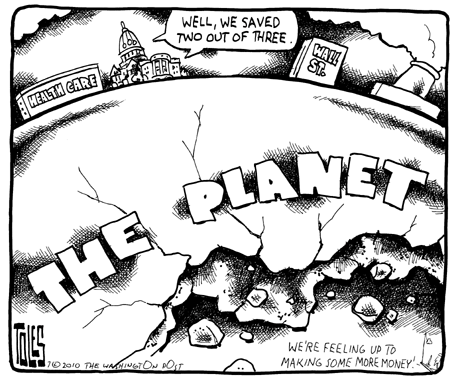 If the latest news reports are any indication, the droughts that have wracked a large portion of the contiguous United States continued piling on the damage in Texas and Oklahoma through 2012. The effects will reverberate for years — and global warming will make such brutal droughts (or worse) the region’s normal climate if we keep listening to the deniers’ call to inaction.
If the latest news reports are any indication, the droughts that have wracked a large portion of the contiguous United States continued piling on the damage in Texas and Oklahoma through 2012. The effects will reverberate for years — and global warming will make such brutal droughts (or worse) the region’s normal climate if we keep listening to the deniers’ call to inaction.
It’s a particular bitter irony, given that the political and media cultures of both states, with Sen. James Inhofe (R-OK) leading the charge, have been contributing enthusiastically to climate change denialism.
The National Oceanic and Atmosphere Administration recently determined that 2012 was the hottest year on record for the lower 48 states, and research by NOAA and other institutions has linked extreme events like Texas and Oklahoma’s drought to climate change. As of December 2012, more than 42% percent of the lower 48 states were experiencing “severe” drought conditions, and 63% of the United States’ new winter wheat crop is in the drought-hit areas.
In Texas in particular, the situation is sufficiently dire that the Republicans in charge of the state are being forced to finally take concrete steps to build new reservoirs and repair the state’s water infrastructure:
In 2011, the last time the Legislature convened for one of its biennial sessions, Representative Allan Ritter, a Republican and the chairman of the House Natural Resources Committee, was unsuccessful in getting lawmakers to approve legislation imposing an annual fee on water users like homeowners and businesses to help finance projects in the state water plan.
But on Thursday, Mr. Ritter proposed bills that would draw $2 billion from the state’s emergency Rainy Day Fund to establish a water infrastructure bank that would lend money for the projects. This time, his proposals received support from Republican leaders and groups that are often on the opposite sides of issues, including the Sierra Club’s Texas chapter, the Texas Association of Business and other industry groups. At least 20 percent of the money available in the fund would be used for conservation and reuse efforts.
“There were people who were trying to talk about water last time, and there wasn’t any money, and there wasn’t the critical mass,” said James Henson, the director of the Texas Politics Project at the University of Texas, Austin. “Elite opinion begins to coalesce after a little while, and it takes people a while to get the issue out there, and I think that’s part of what’s happened with water.”
The Texas drought began in 2010 and is now the third-worst the state has seen since 1895, when record-keeping first began. The Texas Water Development Board estimates that without additional water supplies the state will be short 8.3 million acre-feet of water by 2060 (3.07 acre-feet is equivalent to one million gallons) and the shortfall could cost the state $116 billion that year. Even more tragically, since Texas is a conservative state and stingy with its budgets, the need to address straining water supplies is crowding out other critical investments such as eduction and social services.
The situation is much the same in Oklahoma, according to EnidNews.com. Gary McManus, a climatologist for the Oklahoma Climatological survey, expects the drought to topple state records again going all the way back to 1895:








 “Now no one can deny that the world is getting warmer.” The federally commissioned report [by over 240 scientists] reveals that the US is already reeling under the impact of global warming. [
“Now no one can deny that the world is getting warmer.” The federally commissioned report [by over 240 scientists] reveals that the US is already reeling under the impact of global warming. [ InsideClimate News
InsideClimate News 


 by Andy Darrell, via the
by Andy Darrell, via the 


 If the recent election taught us anything, it’s that we need to re-frame the politics of clean energy.
If the recent election taught us anything, it’s that we need to re-frame the politics of clean energy. by Graham Readfearn, via
by Graham Readfearn, via 
 by James Bradbury and Sarah Parsons, via the
by James Bradbury and Sarah Parsons, via the  The New York Times will close its environment desk in the next few weeks and assign its seven reporters and two editors to other departments. The positions of environment editor and deputy environment editor are being eliminated. [
The New York Times will close its environment desk in the next few weeks and assign its seven reporters and two editors to other departments. The positions of environment editor and deputy environment editor are being eliminated. [
 Language Intelligence: Lessons on persuasion from Jesus, Shakespeare, Lincoln, and Lady Gaga
Language Intelligence: Lessons on persuasion from Jesus, Shakespeare, Lincoln, and Lady Gaga


